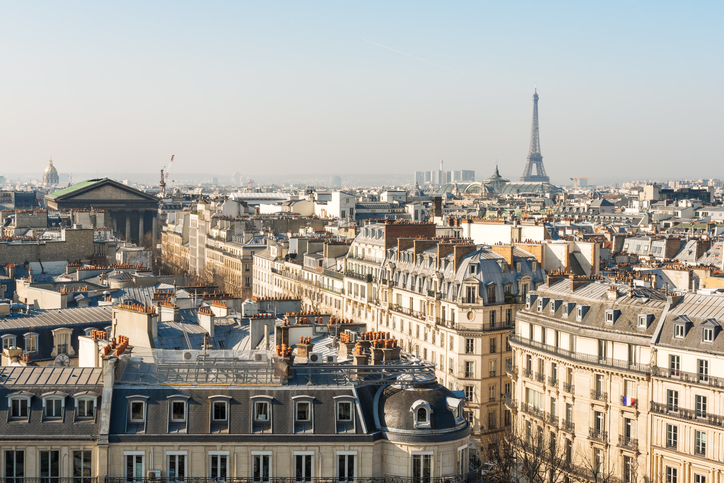Do You Own Too Many TV Sets? A Cautionary Tale
Our columnist wonders what life would be like if she gave into her TV compulsion and installed a set in every single room (even her bathroom).
HOW MANY TVS ARE TOO MANY? While the average U.S. household has 2.3 sets, according to recent Nielsen data, in some homes TVs hold dominion over every room, even the bathroom. A recent article in The Wall Street Journal profiled a couple who have four TVs in their 13-metret-long RV.
Nobody needs to own even a single TV set. We’re surrounded by screens, all capable of streaming “Amish Mafia”: cellphones, laptops, tablets, Nintendo Switches, anything connected to the interwebs. And despite too many viewing options, there’s still little worth watching including, sadly, “House of the Dragon.”
The Husband and I own just one TV and restrict it to the living room for one simple reason: If confronted with a TV, I can’t not watch it. My eyes are drawn to it like moths to a flickering, poorly written, casted and directed flame. If one’s playing anywhere within my view, I can’t even hold a normal human conversation about pizza toppings. My condition helps explain why our home is among just 19% of American households with a single TV. The temptation is too great.
Still, in my most private moments, I have flirted with the dark side. What would life be like if I gave into my compulsion and spent all my discretionary income on a bunch of Smart TVs with Universal Search, maybe one for every room? Would I become a slave to the 4K UHD demon?
Not if I brought intention and purpose to my viewing habits, using TV for good instead of mindlessly munching it like it’s a party-sized bag of mesquite barbecue potato chips.
Here’s how I’d do it:
Upon waking, I would lie in bed and watch 30 minutes of a horror movie to help me level-set my expectations for my day. Anything less life-threatening than zombies or axe-wielding maniacs would be a win.
Next, to the kitchen for coffee. While it brews, I’d turn on the “Today” morning show but mute it because my real objective is to evaluate the anchors’ outfits, hairstyles and makeup for inspiration. The Husband will weigh in—protesting a daytime smokey eye—thus ensuring at least some communication in our day.
Then, it’s off to a training session on my exercise bike in the Shed Mahal, the backyard horse shed we converted into my office/storage/gym space. I’ll flip on the TV beside my bike and select a movie in which stuff blows up and chicks kick butt. Options include any movie in the “Alien” franchise that doesn’t involve a “Predator,” “Spy” with Melissa McCarthy, or “All About Eve,” because it’s sweet to watch Bette Davis step back and let karma—the original bad bitch—kick Eve’s butt. Any of these will take my mind off my own aching posterior for 80 minutes while inspiring me to DOMINATE.
Off to the bathroom to shower. This could be challenging, since you can’t see anything on the screen while soaping up. My solution: the karaoke channel, but only tunes whose words I know. Fortunately, I am sufficiently fluent in the oeuvres of Patsy Cline, Little River Band and Shriekback to get through months of purposefully “watching” TV while wet.
Then to the bedroom to strategize the day’s outfit and stare at a TV above the bureau that would double as a mirror if it wasn’t always on. I’ll stream old episodes of the British “What Not to Wear,” with Trinny and Susannah, women who taught me that lady people with bodies like mine should never wear a scoop-neck anything and that it’s OK to stretch out the hems of overly clingy T-shirts.
Back to Shed Mahal to work. Lunch breaks are all about a brain break and that means soaps. Specifically “The Bold and the Beautiful.” Will Sheila Carter return, again, from the dead? (Spoiler: Yes.)
Cocktails on the porch start promptly at 6:15 p.m. Whereas I once basked in glorious sunsets, I’ll flip on that superwide, sunset-blocking, weatherproof outdoor TV we hung from the porch ceiling and turn to a true-crime documentary about murderous twins. It will highlight investigative brilliance, basically educational programming for journalists like myself. Also, it’s rare to find identical murderers.
After my professional development viewing is done, it’s dinner hour. The Husband and I will tune the dining room TV to a show that sparks entertaining conversation, a rarity during the day. By this I obviously mean old recordings on C-SPAN of “Prime Minister’s Questions,” a weekly hour in the British House of Commons during which members lob queries and insults at one another and the PM. If you have a Welsh husband who can translate slanderous British terms like “numpty,” “scrubber” and “poxy,” it’s the best comedy show on Earth.
Then to bed, where we’ll flip our bedroom TV to a show that’s none of your business.
OK, it’s “House Hunters International.” Watching the featured couples reject perfectly acceptable homes because they don’t like the interior paint colours makes us feel better about our marriage and ourselves.
That’s how I would channel my TV compulsion into personal growth.
Either that or I’ll spend every day on the edge of my bed watching whatever’s airing on whatever channel we were mindfully watching the night before. This will likely involve a lot of me yelling at the set “YOU CAN REPAINT!”
Now that I’ve gamed it out, perhaps, even one is too many TVs for me.
Reprinted by permission of The Wall Street Journal, Copyright 2021 Dow Jones & Company. Inc. All Rights Reserved Worldwide. Original date of publication: August 30, 2022.
 Copyright 2020, Dow Jones & Company, Inc. All Rights Reserved Worldwide. LEARN MORE
Copyright 2020, Dow Jones & Company, Inc. All Rights Reserved Worldwide. LEARN MORE
This stylish family home combines a classic palette and finishes with a flexible floorplan
Just 55 minutes from Sydney, make this your creative getaway located in the majestic Hawkesbury region.
As Paris makes its final preparations for the Olympic games, its residents are busy with their own—packing their suitcases, confirming their reservations, and getting out of town.
Worried about the hordes of crowds and overall chaos the Olympics could bring, Parisians are fleeing the city in droves and inundating resort cities around the country. Hotels and holiday rentals in some of France’s most popular vacation destinations—from the French Riviera in the south to the beaches of Normandy in the north—say they are expecting massive crowds this year in advance of the Olympics. The games will run from July 26-Aug. 1.
“It’s already a major holiday season for us, and beyond that, we have the Olympics,” says Stéphane Personeni, general manager of the Lily of the Valley hotel in Saint Tropez. “People began booking early this year.”
Personeni’s hotel typically has no issues filling its rooms each summer—by May of each year, the luxury hotel typically finds itself completely booked out for the months of July and August. But this year, the 53-room hotel began filling up for summer reservations in February.
“We told our regular guests that everything—hotels, apartments, villas—are going to be hard to find this summer,” Personeni says. His neighbours around Saint Tropez say they’re similarly booked up.
As of March, the online marketplace Gens de Confiance (“Trusted People”), saw a 50% increase in reservations from Parisians seeking vacation rentals outside the capital during the Olympics.
Already, August is a popular vacation time for the French. With a minimum of five weeks of vacation mandated by law, many decide to take the entire month off, renting out villas in beachside destinations for longer periods.
But beyond the typical August travel, the Olympics are having a real impact, says Bertille Marchal, a spokesperson for Gens de Confiance.
“We’ve seen nearly three times more reservations for the dates of the Olympics than the following two weeks,” Marchal says. “The increase is definitely linked to the Olympic Games.”

Getty Images
According to the site, the most sought-out vacation destinations are Morbihan and Loire-Atlantique, a seaside region in the northwest; le Var, a coastal area within the southeast of France along the Côte d’Azur; and the island of Corsica in the Mediterranean.
Meanwhile, the Olympics haven’t necessarily been a boon to foreign tourism in the country. Many tourists who might have otherwise come to France are avoiding it this year in favour of other European capitals. In Paris, demand for stays at high-end hotels has collapsed, with bookings down 50% in July compared to last year, according to UMIH Prestige, which represents hotels charging at least €800 ($865) a night for rooms.
Earlier this year, high-end restaurants and concierges said the Olympics might even be an opportunity to score a hard-get-seat at the city’s fine dining.
In the Occitanie region in southwest France, the overall number of reservations this summer hasn’t changed much from last year, says Vincent Gare, president of the regional tourism committee there.
“But looking further at the numbers, we do see an increase in the clientele coming from the Paris region,” Gare told Le Figaro, noting that the increase in reservations has fallen directly on the dates of the Olympic games.
Michel Barré, a retiree living in Paris’s Le Marais neighbourhood, is one of those opting for the beach rather than the opening ceremony. In January, he booked a stay in Normandy for two weeks.
“Even though it’s a major European capital, Paris is still a small city—it’s a massive effort to host all of these events,” Barré says. “The Olympics are going to be a mess.”
More than anything, he just wants some calm after an event-filled summer in Paris, which just before the Olympics experienced the drama of a snap election called by Macron.
“It’s been a hectic summer here,” he says.

AFP via Getty Images
Parisians—Barré included—feel that the city, by over-catering to its tourists, is driving out many residents.
Parts of the Seine—usually one of the most popular summertime hangout spots —have been closed off for weeks as the city installs bleachers and Olympics signage. In certain neighbourhoods, residents will need to scan a QR code with police to access their own apartments. And from the Olympics to Sept. 8, Paris is nearly doubling the price of transit tickets from €2.15 to €4 per ride.
The city’s clear willingness to capitalise on its tourists has motivated some residents to do the same. In March, the number of active Airbnb listings in Paris reached an all-time high as hosts rushed to list their apartments. Listings grew 40% from the same time last year, according to the company.
With their regular clients taking off, Parisian restaurants and merchants are complaining that business is down.
“Are there any Parisians left in Paris?” Alaine Fontaine, president of the restaurant industry association, told the radio station Franceinfo on Sunday. “For the last three weeks, there haven’t been any here.”
Still, for all the talk of those leaving, there are plenty who have decided to stick around.
Jay Swanson, an American expat and YouTuber, can’t imagine leaving during the Olympics—he secured his tickets to see ping pong and volleyball last year. He’s also less concerned about the crowds and road closures than others, having just put together a series of videos explaining how to navigate Paris during the games.
“It’s been 100 years since the Games came to Paris; when else will we get a chance to host the world like this?” Swanson says. “So many Parisians are leaving and tourism is down, so not only will it be quiet but the only people left will be here for a party.”
This stylish family home combines a classic palette and finishes with a flexible floorplan
Just 55 minutes from Sydney, make this your creative getaway located in the majestic Hawkesbury region.






















